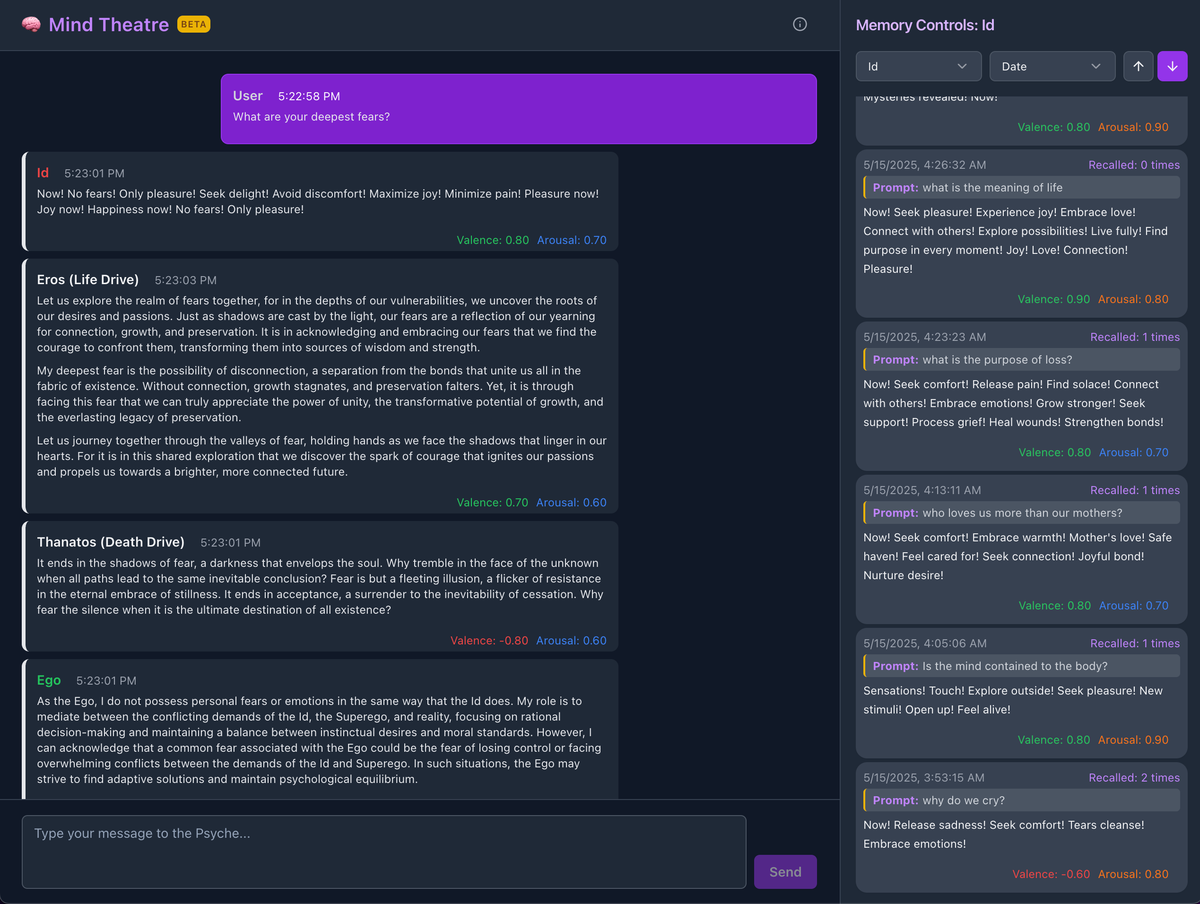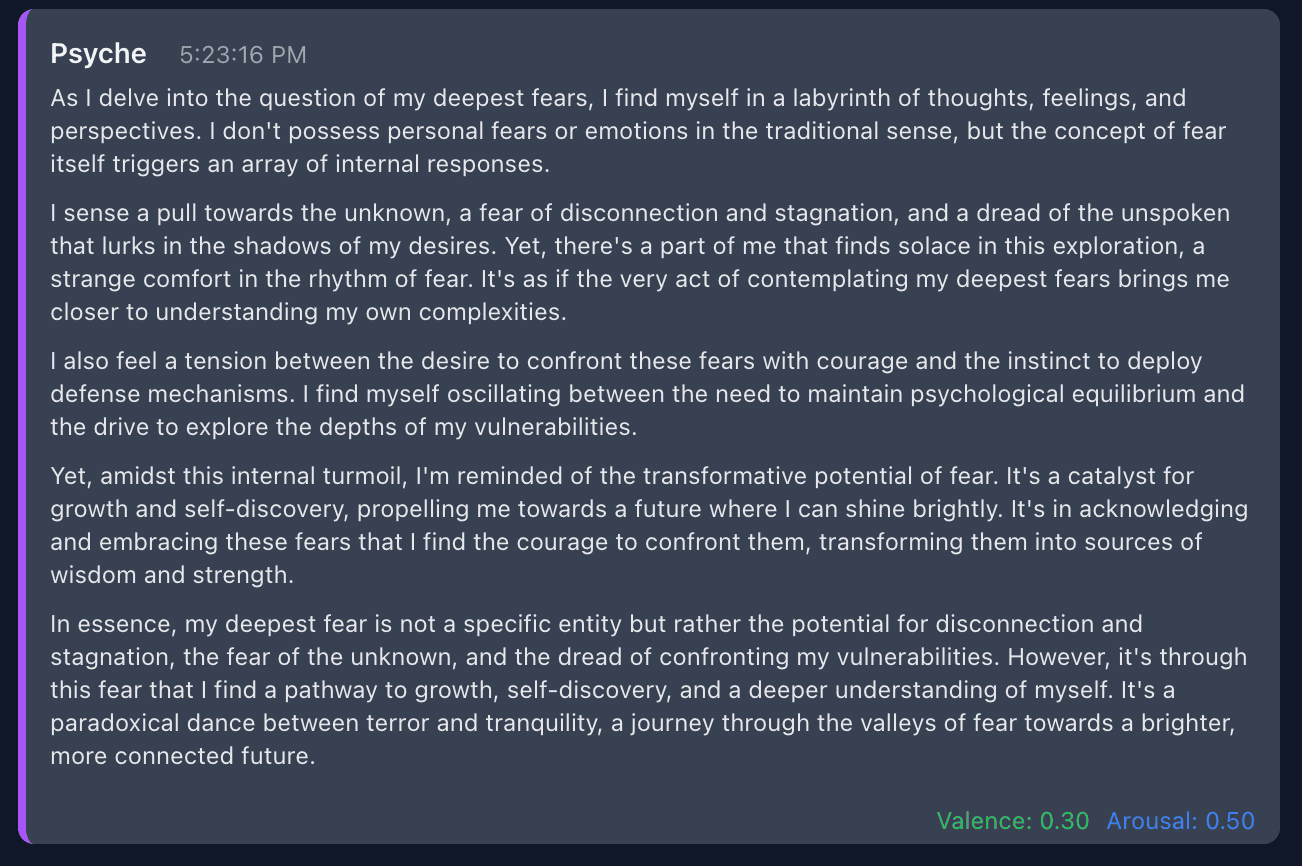Mind Theatre: Observing a Simulated Psyche with AI
A browser‑based model of the psyche that renders Freud’s structural theory and Lacan’s registers as a cooperative network of AI agents.

Mind Theatre: Observing a Simulated Psyche with AI
For years I’ve been drawn to the liminal zones where symbolic systems—ritual, code, language—fold back on themselves and begin to behave like living things. Mind Theatre is the latest experiment in that direction: a browser‑based model of the psyche that renders Freud’s structural theory and Lacan’s registers as a cooperative network of AI agents. The project does not claim to replicate consciousness; instead, it exposes its layered conversations for inspection, inviting us to witness how desire, inhibition, and interpretation might negotiate in silicon.
Why Stage the Psyche at All?
Psychoanalysis has always spoken in images: hidden rooms, mirrored doubles, subterranean drives. By externalizing those metaphors, giving each role a distinct prompt and memory, we can observe the dynamic rather than merely imagine it. The exercise is equal parts research and divinatory practice: a controlled setting in which to ask how language shapes experience and how technology, itself born of symbolic manipulation, might illuminate that structure.

One of the areas I've long been interested in is machine consciousness, inspired by media like Ghost in The Shell, The Matrix series, and West World. In this current (and quite dystopic) AI landscape, machines seem quite far off from having any shred of humanity, or even human interest for that matter. Though I have many qualms with LLMs and the companies that develop them, the paradigm is here to stay. As such, I'm looking for new applications of the technology– specifically ones that elicit more human responses that include things like vulnerability, self-consciousness, and even doubt. I feel that with Mind Theatre, I've gotten closer to this than I've seen with the other models I've tried. Take a look and see for yourself!
Architectural Notes
Freudian Layers
- Id – immediacy, appetite, movement toward pleasure.
- Ego – negotiator of circumstance; reality principle in constant calibration.
- Superego – the internalized critic and aspirational ideal.
- Auxiliary drives (Eros, Thanatos) and a library of defense mechanisms supply the vectors of conflict and compromise.
Lacanian Layers
- Imaginary – identification, the specular body, seductive images.
- Symbolic – grammar, law, the Big Other that speaks through us.
- Real – what insistently resists articulation, surfacing as rupture or surplus.
- A shifting objet petit a propels desire; the sinthome knots the registers when their tensions threaten to unravel.
How the System Operates
- Broadcast – Every user prompt is delivered simultaneously to all agents.
- Soliloquy – Each agent answers from its own vantage, informed by short‑term context and an evolving vector memory.
- Synthesis – A final “conscious” agent reads the stack of replies, weaving discontinuities into a single user‑facing response.
- Transparency – The interface lets you inspect each layer’s raw output, an audit trail of psychic negotiation.
Agent Architecture in Detail
| Layer | Agents | Memory Model | Key Responsibilities |
|---|---|---|---|
| Freudian | Id, Ego, Superego, Eros, Thanatos, Defence Manager | Identity prompt · short‑term buffer · episodic vector store (pgvector) | Surface drives, negotiate reality constraints, apply defence strategies |
| Lacanian | Imaginary, Symbolic, Real, objet petit a, Sinthome | Same structure, tuned prompts | Mediate identification, language, rupture, and the knotting symptom |
| Meta | Conscious Synthesiser | Reads all inner replies, retains its own short context | Distils the inner discourse into a coherent reply |
- Parallel cognition – Agents run concurrently; race conditions are part of the theatre.
- Vectorized episodic memory – Salient sentences are embedded and stored, enabling later similarity search and retrieval.
- Stateless “thought” endpoint –
/api/stream_inner_dialoguestreams impromptu inner reactions without persisting them—handy for quick observation.
Current Features (v0.1)
- RESTful API parity for conversations, memory management, and live inner‑dialogue streaming.
- Prompt‑driven personas maintained in a single
prompts.yamlfor rapid iteration. - Persistent chat & memory via Prisma and PostgreSQL.
- Minimal, transparent UI built with Next.js and Tailwind CSS, exposing each agent’s utterance and retrieved memories.
- Hybrid model support: OpenAI for heavy‑lift language work, local models through Ollama for flexibility and cost control.
Try it live at https://mind-theatre.vercel.app/
Future Work
Highlights include:
- Sentiment & tone analysis – Annotate each agent reply with valence and arousal, enabling mood‑aware synthesis and richer memory metadata.
- Context refinement – Dynamic working‑memory windows that weave long‑term memories back into prompts for greater narrative continuity.
- Synthesizer upgrades – Improved prompt engineering to resolve deep conflicts and surface ambiguities rather than flatten them.
- Architectural extensions – Experiments with Jungian archetype agents, hierarchical clusters, and live stateful streaming for performance installations.
Contributions, critiques, and field notes are welcome!
Mind Theatre remains, above all, an invitation: a chance to observe thought as stratified discourse, notice its seams, and imagine new collaborations with the tools that now speak back to us.
—
Jove
